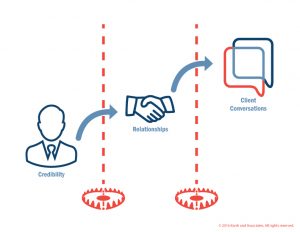In 2013, about one-third of Fortune 500 companies operated public-facing blogs. But just two years later, the Fortune 500 blogging ranks had dwindled to 21 percent, according to an annual study by the University of Massachusetts Dartmouth Center for Marketing Research.
Why are some of America’s corporate giants bailing on blogs? Researchers at UMass Dartmouth suggest that a number of Fortune 500 companies are shifting from word-heavy blogs to “visually rich” platforms like Instagram. From 2014 to 2015, use of Instagram jumped by 13 percent among the Fortune 500 titans, the study says.
The Death of Business Blogging?
So, does this swing portend the death knell for business blogs in general? By and large, PR and marketing pros interviewed for this post think business blogs are here to stay, although they say the types of content on those blogs are morphing.
PR blogger Robert Geller, president of Fusion PR, refutes persistent predictions about the imminent death of business blogging. In fact, Geller thinks business blogging will grow and “remain strong” in 2016.
Someshwar Chidurala, digital marketing analyst at Carrollton, Texas-based tech consulting company Orchestrate Technologies, also expects business blogging to experience an uptick in 2016. Top-quality business blogs will gain fans, Chidurala says, while “the mediocre ones will be on a slippery slope.”
“Your inbound marketing strategy is incomplete without the company blog,” Chidurala says.
For his part, Brett Bastello, SEO manager at Inseev Interactive, a digital marketing agency in San Diego, envisions big companies boosting their blogging in 2016 and small businesses abandoning it. Why? In general, resource-strapped small businesses will see diminishing returns on their blogging investments, he says, while money- and talent-rich big companies will witness bigger returns.
Here are six developments that PR and marketing experts expect to see on the business blogging front throughout 2016.

1. Spotlight on Videos
Tyler Banfield, head of content marketing at Brooklyn, New York-based shoe company Mala, says video is a bigger part of the business blogging picture in 2016, particularly as Facebook ramps up its video strategy. This year, video is critical for business blogs so that the blogs avoid becoming irrelevant, he says.
“Not only does video provide a higher level of engagement with audiences, but it’s also easier to consume on mobile devices,” Banfield says.
2. Less Promotion, More Information
Kyle Kast, a technical writer and communications specialist at Leightronix, a broadcast equipment company in Mason, Michigan, says that rather than engaging in a full-court promotional press, more business bloggers will be cranking out “worthwhile” content sprinkled with promotional snippets.
“Oftentimes, the underlying purpose of a corporate blog is to encourage potential customers to visit the organization’s website,” Kast says. “Presenting material of either educational or entertainment value fulfills just as much, if not more, of that goal than something heavily promotional.”
For instance, Kast foresees more customer vignettes being published on business blogs.
3. Stepped-Up Experimentation
Tom Smith, research analyst at Cary, North Carolina-based DZone, a provider of online content for software professionals, anticipates companies will increasingly diversify their content strategies. Rather than depending solely on standard blog posts, companies will dive more into delivering valuable information via e-books, podcasts, white papers, webinars, community forums, online quizzes, case studies and videos.
Along those lines, Eva Gantz, founder of Giving Books a Voice, a Berkeley, California-based agency that helps authors navigate social media, envisions “adventurous” businesses exploring “dynamic” platforms that will broaden their content reach.
“The core of blogging — storytelling and idea sharing — is already taking hold in fast-growing platforms like Snapchat and Vine, and soon more businesses will get the hang of content sharing in this new form,” Gantz says.

4. Aggregation Via App
Michael Wood, owner of Legalmorning.com, a Wikipedia editing service in Mishawaka, Indiana, predicts more companies will incorporate blog content into their existing apps or will create apps that showcase their content. This will help with indexing of content for mobile searches, he says.
5. Spreading Their Wings
Ryan O’Donnell, director of marketing at Avalara, a sales tax software provider in Bainbridge Island, Washington, expects PR teams to collaborate more closely with company executives and ghostwriters to publish blog content on third-party sites such as Medium, the blogging platform, and LinkedIn, the social network for professionals.
6. Quality vs. Quantity
Jordan Scheltgen, managing partner at Fort Lauderdale, Florida-based content marketing agency Cave Social, says more companies will be steering away from simply pumping out blog content and toward crafting the best content possible, even if it means fewer posts. This helps companies “stand out from the noise,” he says, and provides a better experience for readers.
“It’s no longer good enough to produce high-quality content, because an article can be high-quality but the internet may be flooded with similar articles,” Scheltgen says.
Allison VanNest, head of communications at Parse.ly, a New York City-based provider of audience data and analytics for digital media publishers, thinks that companies not only will be producing more blog content in 2016, but that their content will be taking on a more journalistic tone.
“From American Express to Morgan Stanley, big brands are already taking their content to the next level. This trend will continue as these brands look to audience insights through analytics to craft a strategy around their content,” VanNest says.
Digital & Social Articles on Business 2 Community(44)
Report Post



